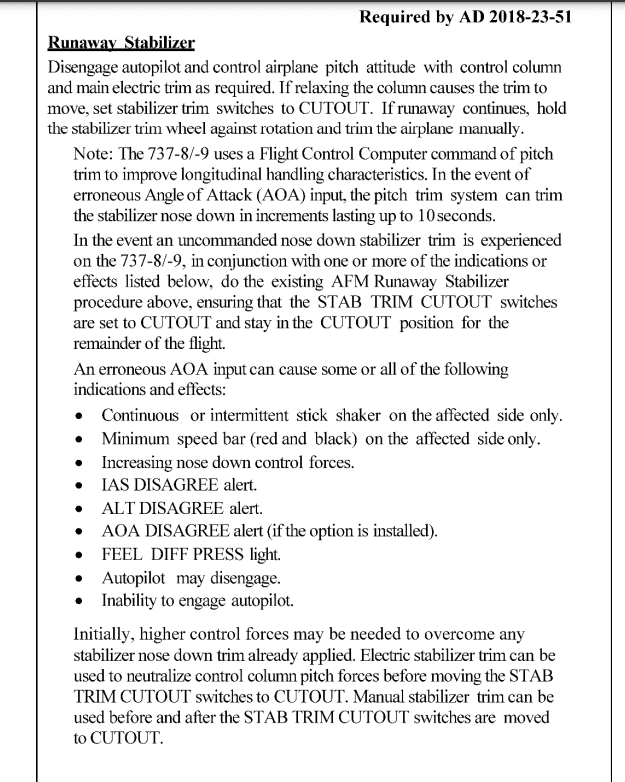"In many cases trying to reengage the autopilot is probably a good idea as many things are made worse by manual intervention."
Autopilot is not a stall recovery system. If the plane is giving a stall warning, real or false, the autopilot isn't to be used.
"Runaway trim as a single issue is almost certainly a lot easier to figure out and the trim motors get cut out if you pull against it normally, but not in MCAS."
Yes, and the second step is that if it doesn't stop from pulling, disable the motors, which is why those switches are right there and the Emergency AD emphasized that fact.
"As I recall the second flight, the aircraft was trimmed nose down and the second pilot was finding it hard to keep the nose up with all that trim. So he tried something which didn't work."
The second accident flight - it was trimmed nose down because the captain did not trim back to neutral before the F/O had the bright idea to shut off access to the simple to use trim button. They didn't monitor any instruments, at least not in any effective way. As airspeed steadily increased no one noticed the engines were still at full take-off thrust even though they were in level flight. Whatever they learned it was in one ear, out the other, likely because the autopilot did all the flying for them.
The MCAS is a variation of how Speed Trim works. An automatic movement of the horizontal stab to feed back to the pilots. Since MCAS is to discourage pilots from pulling harder on the controls, it cannot cutout when pilots pull harder on the controls. This may have caught out the Lion Air crash pilots; it did not catch out the captain from keeping the plane stable. It was emphasized to the Ethiopian crew.
No one said, inside Boeing or outside, "What if a pilot just ignored their training and did all steps the opposite of the manual? Would that cause a problem?" No kidding. It causes a problem when pilots do that.
Boeing employees human beings. Pilots are human beings. How would Boeing employees know more about pilots than pilots do?
As soon as the Emergency AD was issued it became not-a-Boeing responsibility. What made things complicated was the airline and CAA saying the ET-302 pilots followed the Emergency AD instructions perfectly, no mistake was made. A lot of people believed that statement. That Boeing and the FAA had produced a procedure that failed. We don't know if it would or not because ET-302 didn't try it.
Autopilot is not a stall recovery system. If the plane is giving a stall warning, real or false, the autopilot isn't to be used.
"Runaway trim as a single issue is almost certainly a lot easier to figure out and the trim motors get cut out if you pull against it normally, but not in MCAS."
Yes, and the second step is that if it doesn't stop from pulling, disable the motors, which is why those switches are right there and the Emergency AD emphasized that fact.
"As I recall the second flight, the aircraft was trimmed nose down and the second pilot was finding it hard to keep the nose up with all that trim. So he tried something which didn't work."
The second accident flight - it was trimmed nose down because the captain did not trim back to neutral before the F/O had the bright idea to shut off access to the simple to use trim button. They didn't monitor any instruments, at least not in any effective way. As airspeed steadily increased no one noticed the engines were still at full take-off thrust even though they were in level flight. Whatever they learned it was in one ear, out the other, likely because the autopilot did all the flying for them.
The MCAS is a variation of how Speed Trim works. An automatic movement of the horizontal stab to feed back to the pilots. Since MCAS is to discourage pilots from pulling harder on the controls, it cannot cutout when pilots pull harder on the controls. This may have caught out the Lion Air crash pilots; it did not catch out the captain from keeping the plane stable. It was emphasized to the Ethiopian crew.
No one said, inside Boeing or outside, "What if a pilot just ignored their training and did all steps the opposite of the manual? Would that cause a problem?" No kidding. It causes a problem when pilots do that.
Boeing employees human beings. Pilots are human beings. How would Boeing employees know more about pilots than pilots do?
As soon as the Emergency AD was issued it became not-a-Boeing responsibility. What made things complicated was the airline and CAA saying the ET-302 pilots followed the Emergency AD instructions perfectly, no mistake was made. A lot of people believed that statement. That Boeing and the FAA had produced a procedure that failed. We don't know if it would or not because ET-302 didn't try it.

